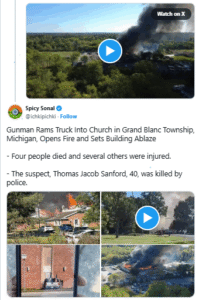Shooter Identified in Deadly Michigan Church Attack and Fire

A devastating act of violence has once again left the United States in mourning after a mass shooting and fire at a Michigan church claimed multiple lives. Authorities have confirmed that at least five people, including the gunman himself, were killed, and more than eight others sustained injuries during the attack. The tragedy unfolded on Sunday morning in Grand Blanc Township at a congregation of the Church of Jesus Christ of Latter-day Saints.
What began as a quiet Sunday worship service quickly descended into chaos. Just after 10:25 a.m., witnesses reported hearing a deafening crash as a vehicle smashed through the church’s main entrance. Within minutes, panic spread among congregants as smoke filled the sanctuary, followed by bursts of gunfire. Soon, photos and videos from bystanders began to circulate on social media, showing heavy black smoke pouring into the sky and flames consuming the roof of the church.
Law enforcement later identified the attacker as Thomas Jacob Sanford, a 40-year-old former U.S. Marine. He was shot and killed by police officers who rushed to the scene. Officials said Sanford drove a vehicle adorned with two American flags directly into the building before stepping out with an assault-style rifle. He opened fire indiscriminately, sending worshippers scrambling for safety as chaos erupted inside the sanctuary.
Authorities reported that Sanford not only fired multiple rounds but also deliberately set a blaze using gasoline, making it even harder for first responders to reach victims. James Deir, Special Agent in Charge of the ATF’s Detroit Field Division, confirmed that the fire was intentionally set by Sanford as part of the attack. Firefighters who arrived quickly were forced to battle both flames and collapsing sections of the structure, which suffered catastrophic damage.
Police Chief William Renye of Grand Blanc Township emphasized the speed of the emergency response. Officers were on site within thirty seconds of the first 911 call, yet the scene they faced was already horrific. “Despite our rapid arrival, multiple victims had already been struck,” Renye said. Ten people with gunshot wounds were rushed to local hospitals, but one later died from their injuries.

By Sunday evening, search crews discovered two more victims inside the charred remains of the church, in addition to those who had been confirmed earlier in the day. The full toll of the tragedy is still unfolding, and officials have withheld the names of the deceased until family members can be notified.
Sanford’s background has come under intense scrutiny in the wake of the attack. Records show that he served in the U.S. Marine Corps between 2004 and 2008, including a deployment to Iraq. In the days after the shooting, more personal details came to light: he was married and the father of a young son diagnosed with congenital hyperinsulinism, a rare and dangerous condition that causes low blood sugar levels. A GoFundMe campaign had been set up in recent months to help cover medical costs for the boy, raising just over $3,000.
The juxtaposition of Sanford’s role as both a father and a gunman has left the community stunned and searching for answers. Investigators are now piecing together his mental health history, relationships, and any possible warning signs that may have preceded the attack. Authorities have promised transparency as the investigation continues, though they have cautioned that motives remain unclear.
Meanwhile, the Grand Blanc Township community is in collective grief. Residents describe a deep sense of disbelief that such violence could strike their town. Local leaders have called for calm and unity, while faith groups and neighborhood organizations are planning vigils and memorial services to remember the victims.
Support networks have also mobilized quickly. Counselors, social workers, and emergency volunteers are working with survivors and grieving families, offering therapy, temporary housing for displaced congregants, and financial assistance. Churches across the state have extended solidarity, pledging resources to help the affected parish rebuild and recover.
Beyond Michigan, the attack has reignited broader national debates on gun control, mental health treatment, and the security of places of worship. Religious institutions across the country are revisiting their safety protocols, while lawmakers and advocacy groups are once again urging stronger protections to prevent similar acts of violence.
Though the physical damage to the church is immense and the emotional wounds run deep, signs of resilience are already emerging. Neighbors have organized donation drives and meal trains for affected families. Candlelight vigils have brought together strangers and friends alike, united in grief but also in determination to heal.
For now, the community mourns its devastating loss. But amid the sorrow, one message resounds: even in the darkest of moments, compassion, unity, and perseverance can carry people forward. As Grand Blanc Township takes its first steps toward healing, the hope is that lessons from this tragedy will bring greater awareness, stronger prevention, and—one day—a future where such heartbreak is no longer repeated.